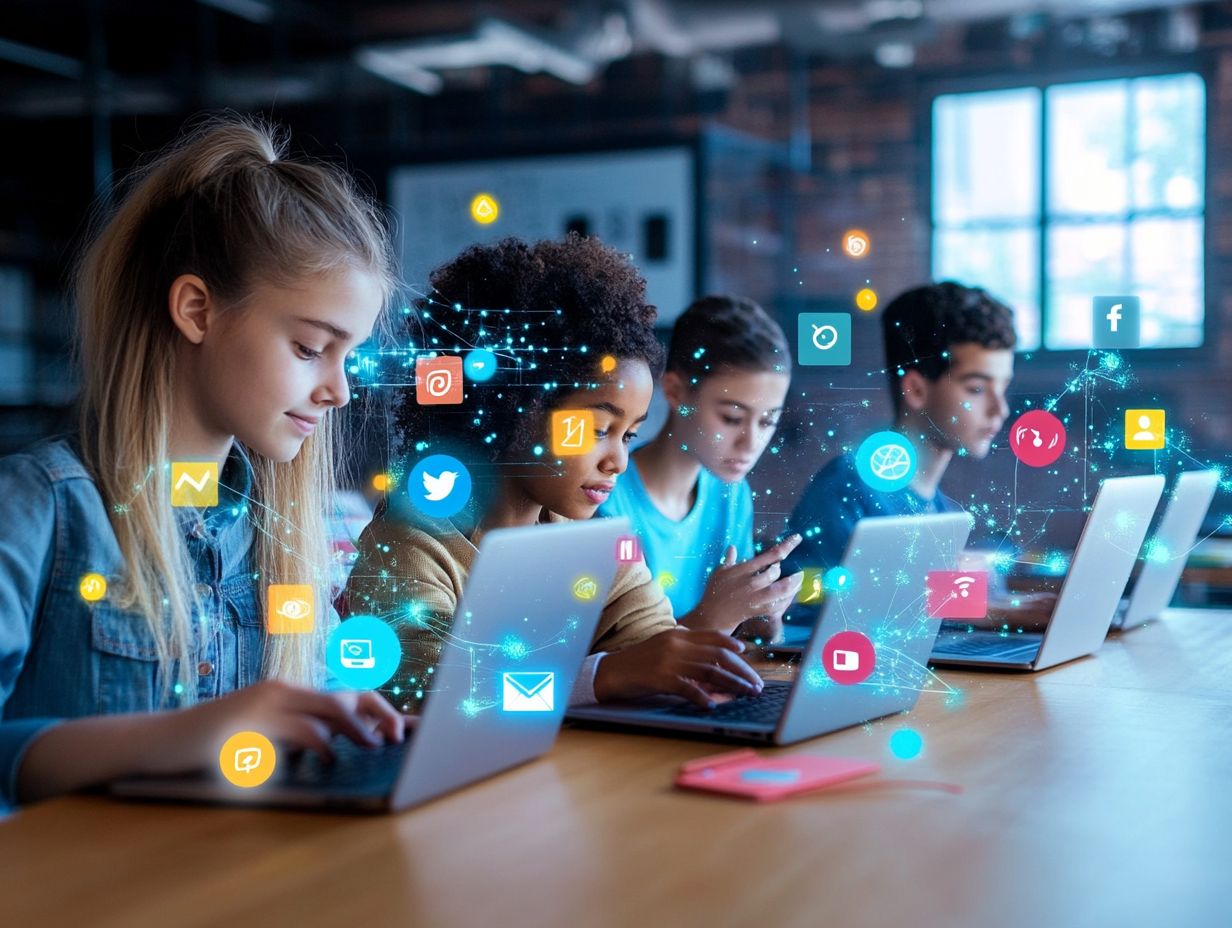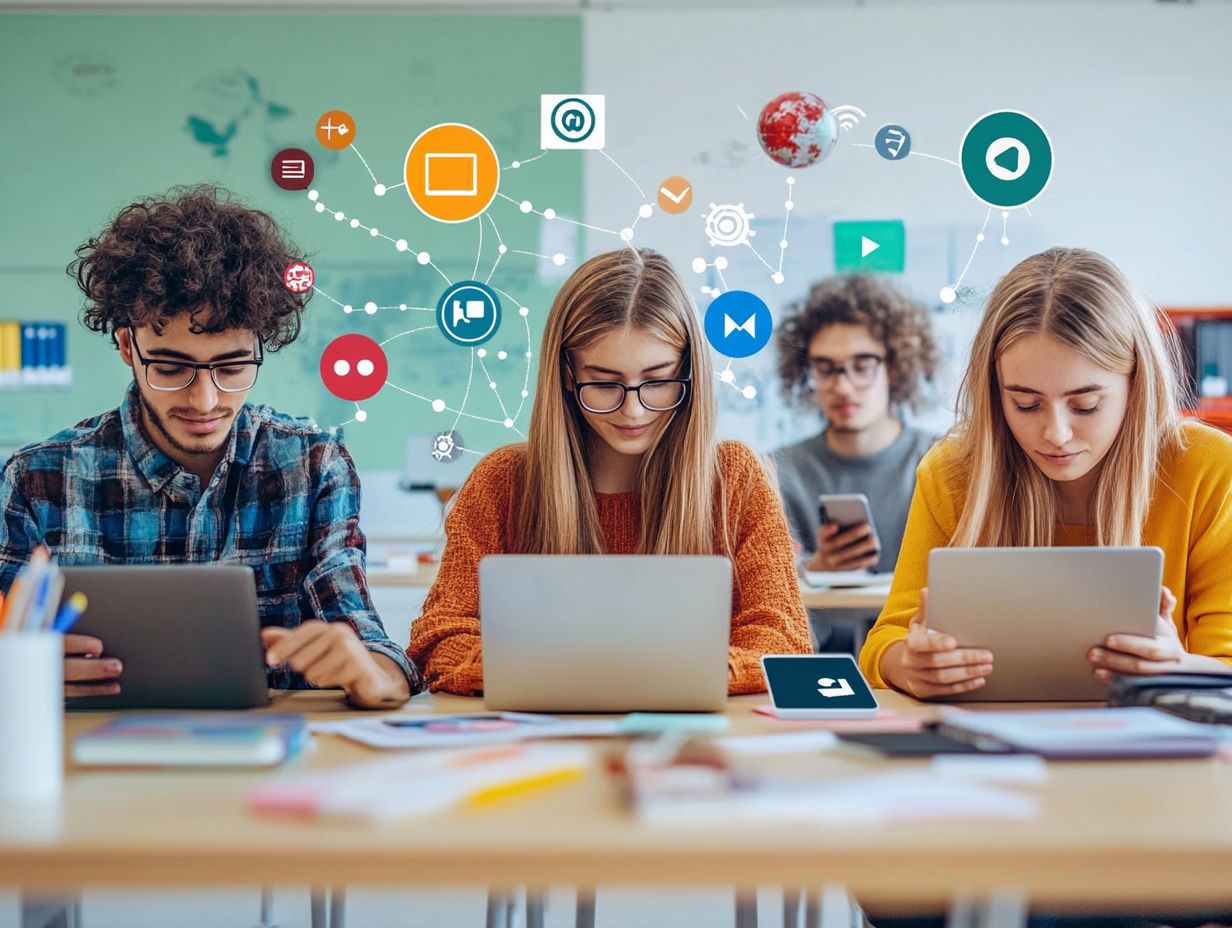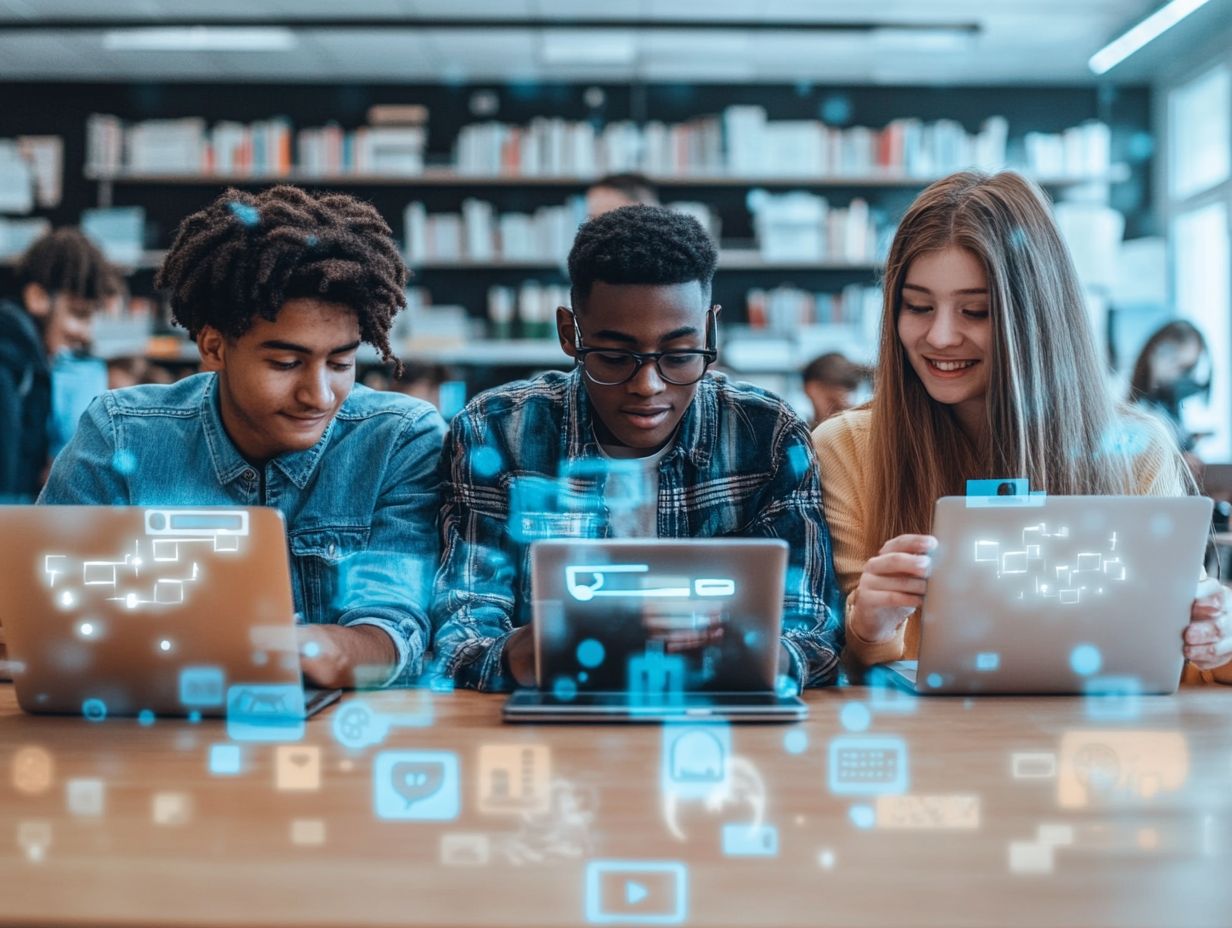Integrating Social Media into E-Learning
The landscape of education is evolving at a breathtaking pace, with social media emerging as a key player in the future of e-learning.
These digital platforms enhance communication and foster collaboration, offering substantial benefits to both students and educators. However, the integration of social media does introduce certain challenges, particularly in terms of privacy concerns and potential distractions.
This article delves into effective strategies for seamlessly incorporating social media into e-learning. It assesses its impact on learning outcomes and discusses future trends that are set to revolutionize education even further.
Join us as we explore the dynamic intersection of social media and e-learning.
Contents
- Key Takeaways:
- Why Social Media Matters in E-Learning
- Ways to Integrate Social Media into E-Learning
- Challenges and Solutions for Using Social Media in E-Learning
- Measuring the Impact of Social Media in E-Learning
- Future Trends in Social Media and E-Learning
- Frequently Asked Questions
- 1. How can social media be integrated into e-learning?
- 2. What are the benefits of integrating social media into e-learning?
- 3. Are there any challenges to integrating social media into e-learning?
- 4. How can social media be used to enhance communication in e-learning?
- 5. Can social media be used for assessment in e-learning?
- 6. Is it necessary to use social media in e-learning?
Key Takeaways:

- Social media is a valuable tool in e-learning, benefiting both students and educators through increased engagement and collaboration.
- Integrating social media into e-learning can be achieved through various strategies, such as incorporating discussions and assignments on social media platforms.
- Challenges like privacy and distractions can be addressed by setting clear guidelines and using specialized platforms. Measuring the impact of social media in e-learning can be done through assessing learning outcomes and engagement.
Why Social Media Matters in E-Learning
In today s digital landscape, you can t underestimate the significance of social media in e-learning. It s a powerful tool that enhances education and fosters digital literacy for both students and educators.
Institutions like Keele University and Texas A&M University are leveraging platforms such as TikTok, Facebook, and LinkedIn to cultivate vibrant learning communities. By engaging students and facilitating peer learning, they re transforming the educational experience.
This approach not only enhances classroom updates but also strengthens alumni networks. It underscores the importance of communication etiquette and makes learning opportunities more accessible and interactive for everyone involved.
Benefits for Students and Educators
Social media offers a wealth of benefits, enhancing connections and improving feedback mechanisms to create a more interactive and effective learning environment.
By harnessing platforms that embrace content created by users, educators encourage collaboration among students. This fosters an atmosphere where sharing ideas and resources becomes second nature.
This approach not only sparks creativity but also promotes deeper engagement with the material. The multimedia capabilities of social media empower you to adopt a dynamic approach to content delivery, incorporating videos, podcasts, and infographics that cater to diverse learning styles.
Creating supportive online community groups allows students to feel connected. This provides a valuable network for assistance, motivation, and shared experiences while significantly enriching their overall educational journey.
Ways to Integrate Social Media into E-Learning
Integrating social media into e-learning demands a well-crafted strategy that utilizes live streaming and engagement techniques. This approach transforms virtual classrooms into dynamically engaging environments, ensuring that educational experiences are not only accessible but also captivating for students.
Don’t wait any longer! Start implementing these social media strategies in your e-learning today and share your experiences with us.
Examples and Strategies

Several esteemed institutions, including Dartmouth College and Chapman University, have implemented social media strategies that enhance online safety and cultivate vibrant community groups among students and educators.
Take Dartmouth College, for example. They use Reddit to facilitate open discussions about campus life while ensuring moderation to protect student privacy.
Similarly, Chapman University uses Instagram to highlight student achievements and events, fostering a sense of belonging and pride within their campus community.
These strategies engage students and promote a supportive environment where online safety is prioritized through regular monitoring and clear guidelines. Balancing community engagement and protective measures is essential for nurturing a positive educational experience in the digital age, leading to higher student satisfaction and participation.
Challenges and Solutions for Using Social Media in E-Learning
Despite the advantages, challenges like privacy concerns and distractions frequently impede effective social media use in e-learning. These issues present significant risks for both students and educators in higher education environments.
Addressing Privacy and Distractions
Addressing privacy and distractions in e-learning requires attention to online safety measures and clear communication etiquette.
It also involves effective feedback mechanisms that encourage responsible social media use. To achieve this, establish clear guidelines for acceptable online behavior, fostering a respectful environment that enhances learning.
Encouraging the use of private messaging for group discussions will help protect personal information while keeping students engaged. Regularly scheduled feedback sessions are essential to adapt teaching methods based on student input, ensuring everyone feels heard and valued.
By using platforms that prioritize privacy and security, you ensure learners feel safe and focused, leading to a more productive online educational experience.
Measuring the Impact of Social Media in E-Learning
Measuring the impact of social media in e-learning is vital for assessing learning outcomes and engagement.
This assessment plays a significant role in fostering digital literacy, which is the ability to use technology effectively, and cultivating robust alumni networks within educational institutions.
Understanding this impact allows you to enhance the overall educational experience and strengthen connections that last beyond the classroom.
Assessing Learning Outcomes and Engagement

Assessing learning outcomes and engagement through social media requires robust feedback mechanisms and thoughtful integration of multimedia content.
This integration fosters deeper connections within community groups. To effectively gauge participation levels, use tools like surveys, polls, and analytics to track interaction metrics.
Techniques like peer assessments and collaborative projects enhance engagement by encouraging active participation. Implementing feedback mechanisms, such as real-time discussions and comments, cultivates a sense of community.
These mechanisms provide immediate insights into learners’ progress. Leverage multimedia content videos, infographics, and podcasts to enrich the educational experience, making it interactive, relatable, and enjoyable, which leads to improved retention of knowledge.
Future Trends in Social Media and E-Learning
As social media evolves, expect future trends in e-learning to be significantly influenced by innovations and advancements.
The focus will likely shift toward peer learning and user-generated content, creating a more collaborative educational environment that enhances your learning experience.
Potential Innovations and Advancements
Potential innovations and advancements in social media for e-learning are set to elevate your digital literacy and refine your ways to connect with students, ultimately enhancing communication within colleges and universities.
Emerging tools, such as interactive video platforms and real-time feedback mechanisms, are transforming education now! By integrating virtual reality experiences and games used to make learning fun, you can immerse yourself in a dynamically educational environment.
The rise of collaborative communication platforms encourages students to connect with each other, fostering a sense of community among learners like yourself.
As educators harness these technologies more effectively, they will not only facilitate your knowledge acquisition but also cultivate the ability to think clearly and solve problems essential for navigating today s digital world. These innovations create a more engaging and inclusive learning experience, bridging gaps in understanding and enhancing your academic performance.
Frequently Asked Questions

Social media can be integrated into e-learning by using platforms such as Facebook, Twitter, and Instagram to engage students in discussions, share course materials, and facilitate collaboration.
Social media makes learning more engaging for students, promotes interaction and collaboration, and provides real-world learning experiences.
Yes, some challenges include privacy concerns, distractions, and the need for proper moderation and management of social media platforms.
Social media can be used as a communication tool through features such as messaging, commenting, and live discussions, making it easier for students and instructors to connect.
Yes, social media can be used for assessment by having students create and share multimedia projects, participate in online debates and discussions, and receive feedback from peers and instructors.
No, it is not necessary to use social media in e-learning. While it can enhance the learning experience, there are other effective tools and methods that can be used for online learning. It ultimately depends on the goals and preferences of the instructor and students.
Explore these tools today and elevate your learning experience!






